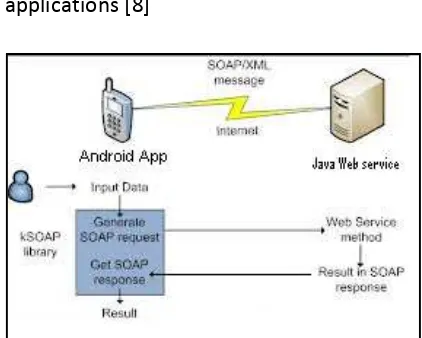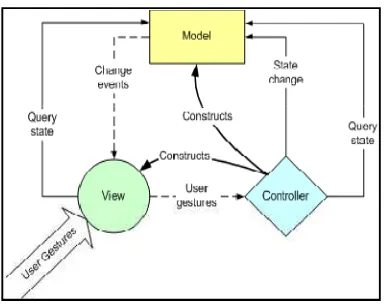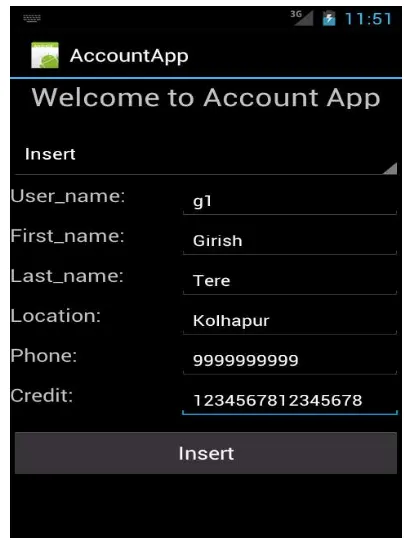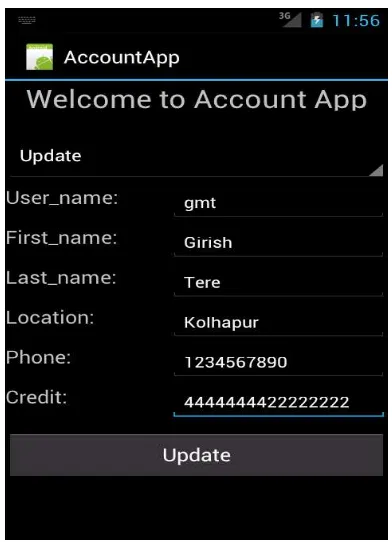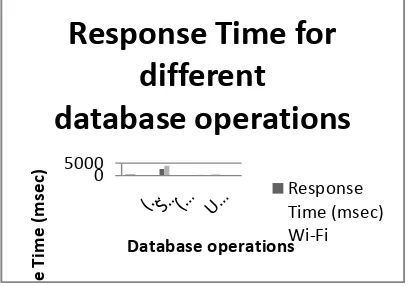Available Online At www.ijpret.com
INTERNATIONAL JOURNAL OF PURE AND
APPLIED RESEARCH IN ENGINEERING AND
TECHNOLOGY
A PATH FOR HORIZING YOUR INNOVATIVE WORK
ANDROID CLIENT FOR ACCESSING DATABASE WEB SERVICE
GIRISH M. TERE, R. R. MUDHOLKAR,B. T. JADHAV
1. Department of Computer Science, Shivaji University, Kolhapur, Maharashtra – 416004, India.
2. Department of Electronics, Shivaji University, Kolhapur, Maharashtra – 416004, India. 3. Department of Electronics and Computer Science, Y.C. Institute of Science, Satara, Maharashtra - 415001, India.
Introduction Currently many organizations are using
cloud computing applications and due to
Accepted Date:
27/02/2013
Publish Date:
01/04/2013
Keywords
Android,
KSOAP,
SOA,
SOAP,
WSDL,
Web services
Corresponding Author Mr. Maulik Patel
Abstract
Web Services, is one of the important means to implement
Service Oriented Architectures. Many organizations are moving
to cloud computing for the proved benefits of cloud
computing. Therefore it is need to develop good mobile based
clients which can access server programs stored in cloud.
Android is major platform in mobiles as well as in tabs. This
paper demonstrates how to develop an Android client which
can access web service. We present the performance results
Available Online At www.ijpret.com
benefits offered by cloud computing more
organizations are attracted for cloud
computing services. For example Google
services, Amazon services, eBay, Paypal
services [12, 17] are more popular in
developers and good efficient client
applications need to be developed for
accessing these cloud based web
applications. For convenience users want to
access the application from their mobiles or
tabs. This paper discusses and
demonstrates a mobile client application
development to access database web
services. In section II use of kSOAP[9] library
is discussed.
Invoking Web Services in Android: the
KSOAP2 solution
Before delving into the KSOAP2 [9] solution
adopted for accessing Web Services on
Android [13, 15] it can be helpful taking a
look at the conceptual model implemented
by the original application as regards Web
Services invocation that we decided to
keep, only modifying its implementation.
Fig. 1: Communication between client and
server
KSOAP [9]: a SOAP open source client
library for mobile Java-based devices, see
fig. 2. KSOAP is an open source SOAP web
service client library [2,7] for constrained
Java environments such as Applets or J2ME
applications [8]
Fig 2: Use of kSOAP library
A.Model-View-Controller(MVC)
MVC is used for separating GUI from
Business Logic and Data Access, Model–
view–controller (MVC) [16] is used as
Available Online At www.ijpret.com
Experiment performed
A.Testbed
Our testbed consists of following computers
and router as shown in Fig 4.
• D-Link DIR-300 Wireless G Router
• DELL INSPIRON with Intel Core2 Duo CPU T6400 @ 2 GHz and 4 GB RAM with
Windows XP
• Karbonn A21 mobile with Android 4.0.4 OS
Fig. 3: MVC design pattern
Web services were developed in J2EE using
Netbeans 7.1.2 and Glassfish Server 3.1.2
were used for deploying web service.
Database used: Java DB (Derby). Android
client application was developed using
Eclipse and Android ICeCream Sandwich
[15] 4.0 OS. Device used was Karbonn A21
Mobile. Server and client are connected
using Wi-Fi [1,11] network as well as tested
using public ip address at server and 2G
network service provided by Tata Docomo
in Karbonn Mobile.
Fig. 4: Test bed for experiment
We performed similar experiments in 2
networks.
1. Using Wi-Fi connectivity
2. Using Bluetooth connectivity
B.Test Application
We developed a web service [14] for
Available Online At www.ijpret.com
operations on a database. This web service
was then published in Glassfish server.
Android application uses this web service
and using kSOAP library above 4 database
operation are performed in mobile.
Web service testing is shown in Fig. 5.
Database Web service’s WSDL is shown in
Fig. 6. Oputput of different database
operations are shown in Fig 7-11. Response
time was measured using
System.milliSeconds() method available in
java.util package [13].
Fig. 5: Web service Testing
Fig. 6: A Web service’s WSDL
Fig. 7: Screen shot of Client app
Available Online At www.ijpret.com
Fig 9: Screen shot of delete operation
Fig. 10: Screen shot of Update operation
Fig. 11: Screen shot of Select operation
Table 1: Response time for various data
operations in different networks.
Operation Response
Time
(msec)
Wi-Fi
Response
Time
(msec)
Bluetooth
Select
(10 records)
546 786
Select
(100 records)
2576 3980
Insert 330 459
Available Online At www.ijpret.com
Delete 238 296
It is observed that more response time is
required if SOAP response message
contains large data. (for e.g. 100 records) To
reduce this time compression technique can
be used.
Fig 12: Response time for different datbase
operations in different network
1 Conclusions
We developed Android client which access
database web service developed in
different platform and published in remote
server. We need to install kSOAP library at
client side for SOAP processing as the
communication between client and server is
via exchanging SOAP messages.
Experiments were performed in different
networking environments and results are
shown here, see Fig. 12. In order to reduce
the response time required for select
operation, SOAP message can be converted
to binary and SOAP compression libraries
can be used at both client and server.
Acknowledgment
We wish to thank teachers of Department
of Computer Science, Shivaji University, for
their constant support and motivation. We
also thank Principal of Thakur College of
Science and Commerce, Mumbai for
allowing us to use resources of institute for
performing the experiments.
References
1. Apte, Deutsch, Jain, “Wireless SOAP:
Optimizations for Mobile Wireless Web
Services”, www (2005),
http://www2005.org/cdrom/docs/p1178.p
df
2. Coulouris, Dollimore, Kindberg,
“Distributed Systems Concepts and Design”,
Addison Wesley 2005
3. DiMarzio, “Android, a Programmer’s
Guide”, McGraw-Hill 2008 0 5000 R e sp o n se Ti m e ( m se c) Database operations
Response Time for
different
database operations
Available Online At www.ijpret.com
4. E. Nahum, T. Barzilai, D. Kandlur,
Performance issues in WWW Servers.
IEEE/ACM Transactions on Networking Vol.
10, No. 1 (February 2002)
5. G. Gans, M. Jarke, S. Kethers, G.
Lakemeyer, “Continuous requirements
management for organization networks: a
(dis-)trust-based approach”, Requirements
Engineering Journal, Vol. 8, No. 1, pp. 4-22,
2003
6. Haseman, “Android Essentials”, Apress
2008
7. J Schiller, Mobile Communications,
Second Addition, Addison-Wesley, 2003
8. “J2ME Web Services Specification”, JSR
172 from Java community process
9. kSOAP, a open source SOAP
implementation for kVM,
http://ksoap.enhydra.org/, May 2004
10.M. Cai, S. Ghandeharizadeh, R. Schmidt,
S. Song, A Comparison of Alternative
Encoding Mechanisms for Web Services,
13th International Conference on Database
and Expert Systems Applications, Aix en
Provence, France, Sep 2002
11.M. Laukkanen, H. Helin, “Web Services
in wireless networks: What happened to
the performance”, in the proceedings of the
2003 Int. Conf. on Web Services – ICWS ’03,
CSREA Press, pp. 278-284.
12.Mark Jones and Paul Krill, InfoWorld:
JavaOne: JavaFirst brings Web Services to
mobile devices,
http://www.javaworld.com/javaworld/jw-06-2003/jw-0612-idgns-mobile.html
13.Meier, “Professional Android
Application Development”, Wiley 2009
14.Nagappan, Skoczylas, Sriganesh,
“Developing Java Web Services”, Wiley
2003
15.Official website for Android developers -
http://developer.android.com Accesesd on
20th Jan 2013
16.Pressman, “Software Engineering, a
Practitioner’s Approach”, McGraw-Hill 2000
17.S. Srirama, “Concept, implementation
and performance analysis of mobile Web
Service provisioning for Smart Phones”,
MasterThesis, RWTH Aachen University,
